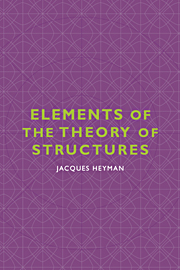Book contents
- Frontmatter
- Contents
- Preface
- 1 The theory of structures
- 2 Virtual work
- 3 Betti, Maxwell, Müller-Breslau, Melchers
- 4 Jettied construction
- 5 Clebsch, Macaulay, Wittrick, Lowe
- 6 The elastica
- 7 Mechanisms of collapse
- 8 The absolute minimum-weight design of frames
- 9 Inverse design of grillages
- 10 The relation between incremental and static plastic collapse
- 11 The bending of a beam of trapezoidal cross-section
- 12 The simple plastic bending of beams
- 13 Leaning walls; domes and fan vaults; the error function ∫e−t2dt
- Bibliography
- Name index
- Subject index
2 - Virtual work
Published online by Cambridge University Press: 18 December 2009
- Frontmatter
- Contents
- Preface
- 1 The theory of structures
- 2 Virtual work
- 3 Betti, Maxwell, Müller-Breslau, Melchers
- 4 Jettied construction
- 5 Clebsch, Macaulay, Wittrick, Lowe
- 6 The elastica
- 7 Mechanisms of collapse
- 8 The absolute minimum-weight design of frames
- 9 Inverse design of grillages
- 10 The relation between incremental and static plastic collapse
- 11 The bending of a beam of trapezoidal cross-section
- 12 The simple plastic bending of beams
- 13 Leaning walls; domes and fan vaults; the error function ∫e−t2dt
- Bibliography
- Name index
- Subject index
Summary
The theory of structures deals with the mechanics of slightly deformable bodies. The ‘slight’ deformations are such that, viewed overall, the geometry of the structure does not appear to alter, so that, for example, equilibrium equations written for the original structure remain valid when the structure is deformed. A familiar example for pin-jointed trusses arises in the resolution of forces at nodes; the inclinations of the bars are assumed to remain fixed with respect to a set of reference axes. For beams and frames, deflexions within the length of a member are ‘small’ compared with the length of that member, and so on.
Thus when overall equilibrium equations are written for slightly deformable structures they are identical with those obtained by rigid-body statics. The use of the equation of virtual work to obtain such relations between the external forces acting on rigid bodies can be traced back to Aristotle (384–322 BC), to Archimedes (287–212 BC) with his formulation of the laws of the lever, and, in more recent times, to Jordan of Nemore in the thirteenth century AD. The insight obtained by the use of virtual work in the study of rigid bodies is deep, but the application is straightforward. In effect, the simplifying concept of an energy balance is used to obtain relations between external forces by the study of a small rigid-body displacement (which need not be a possible displacement for the structure in question – hence ‘virtual’).
- Type
- Chapter
- Information
- Elements of the Theory of Structures , pp. 11 - 20Publisher: Cambridge University PressPrint publication year: 1996



